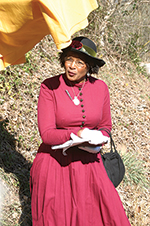



Long-awaited Marker
Madison historical marker erected for Underground Railroad conductor
The city’s 14th marker commemorates Chapman Harris
(December 2016) – A group of 20 people on Nov. 18 gathered near Eagle Hollow, located along State Road 56 about three miles east of Madison, Ind., to celebrate the unveiling of a long-awaited historical marker to honor the legacy of Underground Railroad conductor Chapman Harris.
The historical marker was erected by Indiana Department of Transportation since it was placed along a state highway. The marker is in view of the Ohio River, where many slaves secretly crossed to escape north to freedom.
 |
Photo by Don Ward A group of 20 people attended a short ceremony Nov. 18 three miles east of Madison, Ind., where a historical marker was dedicated to commemorate the work of Underground Railroad conductor Chapman Harris. |
The ceremony was highlighted by a short speech from Madison re-enactor Sue Livers, who portrays Harris’ wife Patsy Ann. Livers wore period dress to make her presentation.
Harris was born in Virginia around 1802. He was a laborer, farmer and Baptist minister. His activities as a free African American aiding escaping slaves started in the mid-1840s.
Livers explained that Patsy Ann was 20 and Harris 39 when they married. The couple then moved to Indiana around 1839 and purchased 21 acres of land for $75.26 near Eagle Hollow in eastern Jefferson County. Harris also owned property on Walnut Street in Madison.
Livers, as Patsy Ann, said Harris was a large man – standing nearly seven feet tall and weighing 230 pounds. “He was called the ‘Black Apostle of Freedom’ for his work in the Underground Railroad.” She noted that Chapman was arrested on Nov. 26, 1856, in Louisville, Ky., for being caught in the state having in his possession a flint, pocket knife and money.
Harris was perhaps the most prominent Under-ground Railroad worker in the area, according to a short history on the Indiana Historical Bureau’s website.
 |
Photo by Don Ward Re-enactor Sue Livers tells a brief history of Chapman Harris’ wife, Patsy Ann, during the historical marker dedication ceremony on Nov. 18. |
Shortly after his 1837 arrival, Harris and his two eldest sons began working with local Underground Railroad leaders. Known for his size and tremendous strength, Harris helped move freedom seekers along the Hanover route toward Lancaster, Ind.
A blacksmith by trade, Harris devised an ingenious mode of communication to notify both other agents and slaves on the opposite shore of the Ohio River that he or his sons were about to row their skiff across and all who wanted to accompany them back were welcome. Outside his home at Eagle Hollow, three miles east of Madison, Harris placed an iron plate or anvil in the trunk of a sycamore tree. When the time came to go across the Ohio to pick up fugitives, he would hammer on the anvil.
Harris was endangered at least twice during his activities as a pilot. Once, another black, John Simmons, also privy to information about the activities, made the nearly fatal mistake of divulging what he knew. Harris and a fellow black worker, Elijah Anderson, led a group of men who nearly whipped Simmons to death.
Apparently, the only thing that saved the informer's life was that he bit part of Harris' lip off. On this evidence, a judge of the circuit court in Jefferson County convicted Harris of the beating and fined him several hundred dollars.
Harris died in 1890.
 |
Photo by Don Ward Posing beneath the Chapman Harris historical marker are (from left) re-enactor Sue Livers, tourism director Linda Lytle, Jefferson County Commissioner Bob Little and Andrew Forrester, the city’s Community Relations Manager. |
Jefferson County Commissioner Bob Little also read a passage about Chapman, and newly hired VisitMadison Inc. tourism director Tawana Thomas called the ceremony to order.
Also attending were representatives from the Indiana Historical Bureau in Indianapolis, The bureau administers the statewide historical marker program.
“We gather here today to honor a man and to never forget Chapman Harris and the difference he made in the lives of the people of his day,” Thomas said.
Casey Pfeiffer, who manages the historical marker program at the bureau, said this was the 14th marker in Jefferson County. Historical markers can be found in 88 of Indiana’s 92 counties, she said.
“They cover a variety of topics,” Pfeiffer said. “They provide snapshots of the past.”
In all, the bureau has installed more than 600 historical markers across the state, she said.
“There seems to be an increase in the interest in preserving our history – especially this year with the Indiana Bicentennial.”
While the bureau used to pay for installing the markers, each county or organization must pay for them now. It costs $2,200 to create and install a marker, Pfeiffer said.
The Chapman Harris historical marker was paid for with money from the county’s History Fund, part of the money the county receives from Belterra Casino receipts.
